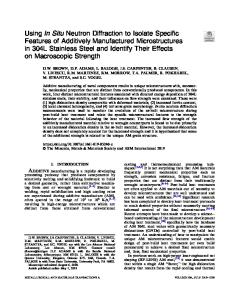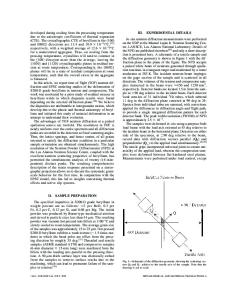In situ characterization of polycrystalline ferroelectrics using x-ray and neutron diffraction
- PDF / 1,490,740 Bytes
- 17 Pages / 584.957 x 782.986 pts Page_size
- 47 Downloads / 386 Views
In situ characterization of polycrystalline ferroelectrics using x-ray and neutron diffraction Giovanni Esteves, Chris M. Fancher, and Jacob L. Jonesa) Department of Materials Science and Engineering, North Carolina State University, Raleigh, North Carolina 27695, USA (Received 15 June 2014; accepted 3 October 2014)
X-ray and neutron diffraction are particularly useful for characterizing ferroelectric materials in situ, e.g., during application of temperature, pressure, electric field, and stress. In this review, we introduce many experimental approaches for such measurements and highlight important discoveries in ferroelectrics that utilized diffraction. We focus our examples on polycrystalline ferroelectrics, though many of the approaches and analysis methods can also be applied to thin films and single crystals. Methods discussed for characterization of structure include, phase identification, line profile analysis, whole pattern fitting, pair distribution functions, and the x-ray diffraction based three-dimensional microscopy. Further advancement of these and other techniques offers potential for continued important contributions to the fundamental understanding of ferroelectric materials.
I. INTRODUCTION
Over the past 100 years, x-ray and neutron diffraction techniques have become powerful tools for material characterization. X-ray and neutron sources, optics, and detector technologies have advanced throughout the years, providing even greater insight into the crystallographic structure of materials. In materials science, in situ diffraction measurements provide valuable structural information of structure–property relationships, changes in structure with applied stimuli, and the application of this information to material processing. The importance of understanding the structure of a material and its response to a stimulus is vital to discover, produce, and understand the next generation of materials. Because the properties of ferroelectric materials are strongly dependent upon their structures, advances in the realm of in situ diffraction studies have been particularly useful to researchers in the field of ferroelectrics, e.g., enabling the distinction of subtle structural differences between different polymorphic structures, observing and quantifying the behavior of ferroelectric domains under applied electric field stimulus, and determining the characteristics of phase transitions with temperature and pressure. X-ray and neutron diffraction are similar techniques and provide complementary information about a material, but differ in their scattering properties. X-rays interact with the electron cloud of an atom, therefore their scattering power is a function of the atomic number, and decreases in a)
Address all correspondence to this author. e-mail: [email protected] DOI: 10.1557/jmr.2014.302 J. Mater. Res., 2014
http://journals.cambridge.org
Downloaded: 17 Nov 2014
intensity at higher 2h angles. X-ray tube sources are readily available in most university and industry laboratories, making x-ray diffractio
Data Loading...











